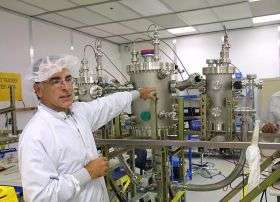Rafe Schindler in the LSST clean room.
Contamination is the enemy for Large Synoptic Survey Telescope collaborators Rafe Schindler and a team of SLAC scientists and technicians working in Light Assembly Building 33. The clean room, which requires shoe covers, hair nets and immaculately cleaned nylon lab coats, will house the construction of the camera for the Large Synoptic Survey Telescope (LSST). But before work begins on the three-ton camera, Schindler's team is building a suite of high vacuum chambers to test materials for use in its construction.
"We're starting early because this research on potential materials impacts the entire downstream design and construction of every other component in proximity to the optical elements of the camera," said Schindler.
The LSST will scan the entire southern hemisphere every other night. Its camera will comprise 21 sub-cameras, each comparable to the largest camera on a telescope today. Delicately placed side-by-side, no more than a few hundred microns apart, the cameras' minute separations will minimize dead space. The result will be one large camera with an imaging surface nearly three-quarters of a meter wide and almost perfectly flat.
"This is a game of tolerances," says Schindler. "This part of the project pushes the limits of modern manufacturing and metrology."
But before parts can be manufactured, materials must be tested to ensure they will not create contaminants in the focal plane's environment that could interfere with picture taking. If dirt, dust or a thin film—like a fingerprint—contaminates an average digital camera, it would take a few minutes to take apart, clean and reassemble. If the LSST's camera is contaminated, it could take 6 to 12 months to repair, and possibly damage the delicate sensors of the focal plane.
Because of the long repair time, it is imperative that the camera be made out of materials that won't contaminate its imaging surfaces over the expected 10-year lifetime. Schindler’s team is building a contamination chamber that will test camera components and their preparation for vacuum use to find which materials are acceptable.
"Our test facility should create a new standard for preparation and qualification of materials for all future optical instruments of the same scale," says Schindler.
The contamination chamber will be ready for material testing in a couple of months, after it is transferred to new laboratory space on Stanford's main campus. The clean room and Building 33 will eventually be used for the camera's assembly. When completed, the camera will take four images a minute, with each image file containing about 10,000 times more data than a good digital camera in today's market.
"For the field of particle astrophysics the LSST project as a whole will herald a revolution akin to that which took place in accelerator–based particle physics in the early 70's, with the emergence of single dedicated experiments based on large solid angle spectrometers," said Schindler.
Source: by Ken Kingery, SLAC Today
























